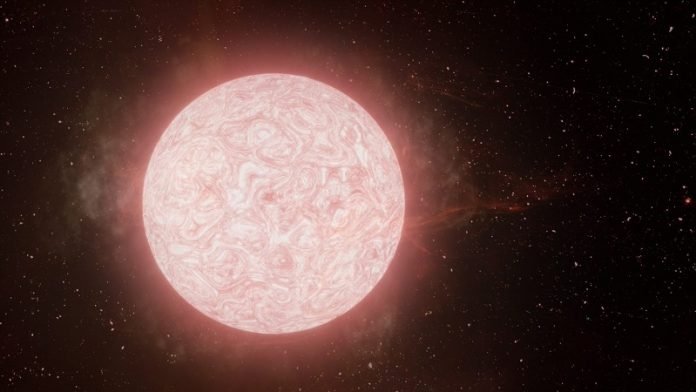
For the first time ever, astronomers have imaged in real time the dramatic end to a red supergiant’s life — watching the massive star’s rapid self-destruction and final death throes before collapsing into a type II supernova.
Led by researchers at Northwestern University and the University of California, Berkeley (UC Berkeley), the team observed the red supergiant during its last 130 days leading up to its deadly detonation.
The discovery defies previous ideas of how red supergiant stars evolve right before exploding.
Earlier observations showed that red supergiants were relatively quiescent before their deaths — with no evidence of violent eruptions or luminous emissions.
The new observations, however, detected bright radiation from a red supergiant in the final year before exploding.
This suggests at least some of these stars must undergo significant changes in their internal structure, which then result in the tumultuous ejection of gas moments before they collapse.
“This is a breakthrough in our understanding of what massive stars do moments before they die,” said Wynn Jacobson-Galán, the study’s lead author.
“Direct detection of pre-supernova activity in a red supergiant star has never been observed before in an ordinary type II supernova. For the first time, we watched a red supergiant star explode.”
The discovery was published in The Astrophysical Journal.
‘We’ve never confirmed such violent activity’
The University of Hawaiʻi Institute for AstronomyPan-STARRS on Haleakalā, Maui, first detected the doomed massive star in summer 2020 via the huge amount of light radiating from the red supergiant.
A few months later, in fall of 2020, a supernova lit the sky.
The team quickly captured the powerful flash and obtained the very first spectrum of the energetic explosion, named supernova 2020tlf (SN 2020tlf) using the W.M. Keck Observatory’s Low Resolution Imaging Spectrometer on Maunakea, Hawaiʻi.
The data showed direct evidence of dense circumstellar material surrounding the star at the time of explosion, likely the same gas that Pan-STARRS had imaged the red supergiant star violently ejecting earlier in the summer.
“It’s like watching a ticking time bomb,” said Raffaella Margutti, an adjunct associate professor at CIERA and the paper’s senior author.
“We’ve never confirmed such violent activity in a dying red supergiant star where we see it produce such a luminous emission, then collapse and combust, until now.”
The team continued to monitor SN 2020tlf after the explosion. Based on data obtained from Keck Observatory’s Deep Imaging and Multi-Object Spectrograph and Near Infrared Echellette Spectrograph, the researchers determined SN 2020tlf’s progenitor red supergiant star — located in the NGC 5731 galaxy about 120 million light-years away from Earth — was 10 times more massive than the sun.
Remote possibilities
Margutti and Jacobson-Galán conducted most of the study during their time at Northwestern, with Margutti serving as an associate professor of physics and astronomy and member of CIERA, and Jacobson-Galán as a graduate student in Margutti’s research group.
Margutti is now an associate professor of astronomy and astrophysics at UC Berkeley.
Northwestern’s remote access to Keck Observatory’s telescopes was integral to their research. From the University’s Evanston campus, astronomers can connect with an on-site telescope operator in Hawaiʻiand choose where to position the telescope.
By bypassing long-distance travel to Hawaiʻi, astronomers save precious observing time — often catching transient events like supernovas, which can quickly flare up and then swiftly vanish.
“This significant discovery of a red supergiant supernova is yet one more strong indication of the importance of Northwestern’s investment in access to top private telescope facilities, including the Keck Observatory,” said Vicky Kalogera, the Daniel I. Linzer Distinguished University Professor of Physics and Astronomy at Northwestern’s Weinberg College of Arts and Sciencesand director of CIERA.
“The Keck telescopes, currently the best on our planet, uniquely enable scientific advances of this caliber as CIERA researchers have shown since our Keck partnership started just a few years ago.”
Margutti, Jacobson-Galán and their Northwestern co-authors are members of the Young Supernova Experiment, which uses the Pan-STARRS telescope to catch supernovae right after they explode.
“I am most excited by all of the new ‘unknowns’ that have been unlocked by this discovery,” Jacobson-Galán said.
“Detecting more events like SN 2020tlf will dramatically impact how we define the final months of stellar evolution, uniting observers and theorists in the quest to solve the mystery on how massive stars spend the final moments of their lives.”
The study, “Final Moments I: Precursor emission, envelope inflation and enhanced mass loss preceding the luminous type II supernova 2020tlf,” was supported by NASA, the National Science Foundation, the Heising-Simons Foundation, the Canadian Institute for Advanced Research, the Alfred P. Sloan Foundation and VILLUM FONDEN.



